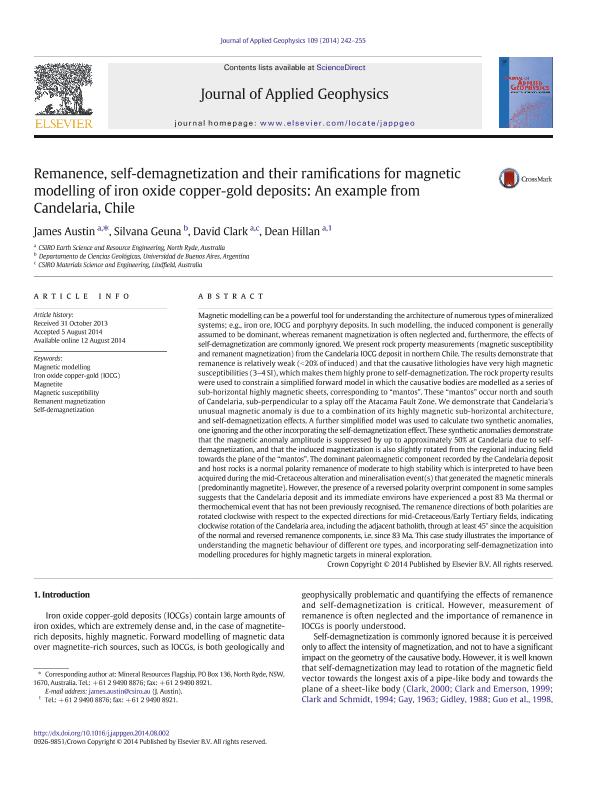Artículo
Remanence, self-demagnetization and their ramifications for magnetic modelling of iron oxide copper-gold deposits: An example from Candelaria, Chile
Fecha de publicación:
10/2014
Editorial:
Elsevier Science
Revista:
Journal Of Applied Geophysics
ISSN:
0926-9851
Idioma:
Inglés
Tipo de recurso:
Artículo publicado
Clasificación temática:
Resumen
Magnetic modelling can be a powerful tool for understanding the architecture of numerous types of mineralized systems; e.g., iron ore, IOCG and porphyry deposits. In such modelling, the induced component is generally assumed to be dominant, whereas remanent magnetization is often neglected and, furthermore, the effects of self-demagnetization are commonly ignored. We present rock property measurements (magnetic susceptibility and remanent magnetization) from the Candelaria IOCG deposit in northern Chile. The results demonstrate that remanence is relatively weak (b20% of induced) and that the causative lithologies have very high magnetic susceptibilities (3–4 SI), which makes them highly prone to self-demagnetization. The rock property results were used to constrain a simplified forward model in which the causative bodies are modelled as a series of sub-horizontal highly magnetic sheets, corresponding to “mantos”. These “mantos” occur north and south of Candelaria, sub-perpendicular to a splay off the Atacama Fault Zone. We demonstrate that Candelaria's unusual magnetic anomaly is due to a combination of its highly magnetic sub-horizontal architecture, and self-demagnetization effects. A further simplified model was used to calculate two synthetic anomalies, one ignoring and the other incorporating the self-demagnetization effect. These synthetic anomalies demonstrate that the magnetic anomaly amplitude is suppressed by up to approximately 50% at Candelaria due to selfdemagnetization, and that the induced magnetization is also slightly rotated from the regional inducing field towards the plane of the “mantos”. The dominant paleomagnetic component recorded by the Candelaria deposit and host rocks is a normal polarity remanence of moderate to high stability which is interpreted to have been acquired during the mid-Cretaceous alteration and mineralisation event(s) that generated the magnetic minerals (predominantly magnetite). However, the presence of a reversed polarity overprint component in some samples suggests that the Candelaria deposit and its immediate environs have experienced a post 83 Ma thermal or thermochemical event that has not been previously recognised. The remanence directions of both polarities are rotated clockwise with respect to the expected directions for mid-Cretaceous/Early Tertiary fields, indicating clockwise rotation of the Candelaria area, including the adjacent batholith, through at least 45° since the acquisition of the normal and reversed remanence components, i.e. since 83 Ma. This case study illustrates the importance of understanding the magnetic behaviour of different ore types, and incorporating self-demagnetization into modelling procedures for highly magnetic targets in mineral exploration.
Archivos asociados
Licencia
Identificadores
Colecciones
Articulos(IGEBA)
Articulos de INSTITUTO DE GEOCIENCIAS BASICAS, APLICADAS Y AMBIENTALES DE BS. AS
Articulos de INSTITUTO DE GEOCIENCIAS BASICAS, APLICADAS Y AMBIENTALES DE BS. AS
Citación
Austin, James; Geuna, Silvana Evangelina; Clark, David; Hillan, Dean; Remanence, self-demagnetization and their ramifications for magnetic modelling of iron oxide copper-gold deposits: An example from Candelaria, Chile; Elsevier Science; Journal Of Applied Geophysics; 109; 10-2014; 242-255
Compartir
Altmétricas




